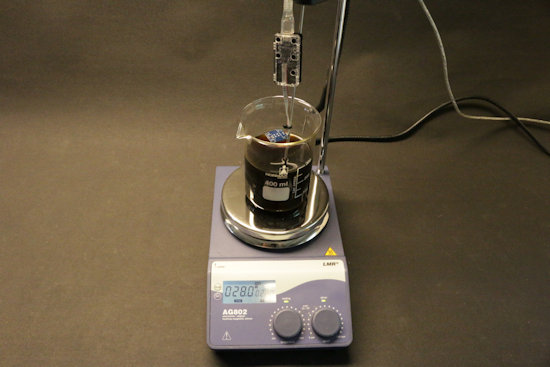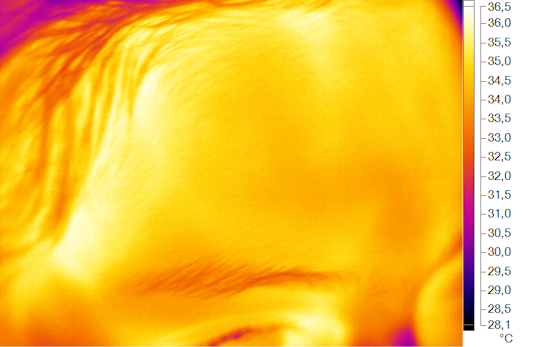 As several countries are starting to alleviate the containment rules, we are receiving many requests concerning our infrared temperature sensor, the Yocto-Temperature-IR. Indeed, the possibility to quickly and without contact detect people who may be sick seems interesting. But is it as easy as it seems?
As several countries are starting to alleviate the containment rules, we are receiving many requests concerning our infrared temperature sensor, the Yocto-Temperature-IR. Indeed, the possibility to quickly and without contact detect people who may be sick seems interesting. But is it as easy as it seems?
Measure accuracy
First, we set up a small experiment to validate the announced accuracy of the Yocto-Temperature-IR. Using a small laboratory stirrer, we heated a liquid in a beaker to 37░C and measured its temperature from a distance of 5cm using a Yocto-Temperature-IR. A Pt100 probe immersed right below the surface gives us the reference value.

Infrared thermometer test setup
The result is perfectly conform to the expectations: the difference between the Pt100 probe measure under the surface and the contact-less infrared measure of the surface is at most of a few tenths of degrees.
We performed the experiment with clear water and then with coffee, to make sure that the color of the measured liquid didn't influence the infrared measures.
From there, there is a great temptation to create a device to measure the temperature of people by simply measuring the temperature of their forehead. Except that...
Medical diagnosis application
The interesting temperature for a medical diagnosis is the internal temperature. By definition, it's not the same as the temperature at the surface of our skin, because the body is designed to prevent heat loss, and the skin is relatively insulating. If we look at the thermal image of a forehead, we notice that the surface temperature is not of the 37░C typically expected for an active individual in good health:

Thermal image of a forehead
Depending on the exterior temperature, the difference can be quite important. So, how do medical infrared thermometers work? There are two main types.
Infrared ear thermometers are used in the ear: the principle is to measure the eardrum temperature. Actually, this thin membrane in the depth of the ear is one of the rare part of our envelop which is actually at the internal temperature. The difficulty of the measure on the eardrum resides in orienting the infrared sensor precisely towards the eardrum. If the sensor doesn't target only the eardrum, the measure is averaged on the whole of the measured surface, and the measure is therefore incorrect. Therefore, it's usually a measure which is performed by trained medical personnel who are used to the exact gesture, but this is not within everyone's reach. Moreover, inserting a measuring device in the ear is not really what you can call "contact-less", so this is not what people are looking for at the moment...
Infrared temporal thermometers take the temperature on the forehead. Actually, it's not the forehead that they try to measure, but the superficial temporal artery which crosses the forehead at a precise location. As this spot is not easy to determine, the measuring protocol consists usually in scanning the forehead from the center to the side and to keep the maximal value, which should happen at the time where the thermometer crosses the temporal artery. There as well, the difficulty of the measure resides in measuring the precise location (the artery) without averaging with the temperature of the surrounding skin.
Is the Yocto-Temperature-IR adapted for these measures? Not as is, in any case. On the one hand, we would need to add an optic to focus the viewing angle on the smaller zone, or connect an separate MLX90614-ESF-DCI sensor supported by the Yocto-Temperature-IR and which provides a much more restrained viewing angle. But to efficiently perform a scan to look for the temporal artery, we would need a refresh rate higher that what the Yocto-Temperature-IR allows us. Moreover, the precision of temporal temperature measurements is not a given fact at the medical level.
At the end of the day, we recommend that you limit the field of use of the Yocto-Temperature-IR to less punctual measures than the ones required for medical diagnosis. The Yocto-Temperature-IR is ideal for example to measure without contact the temperature of objects, ready-to-eat meals, lab environments, samples, and so on.


